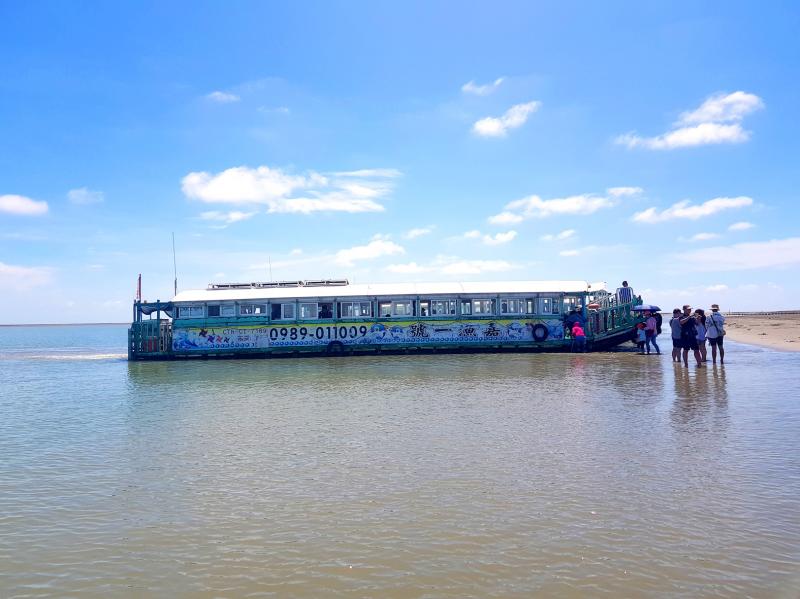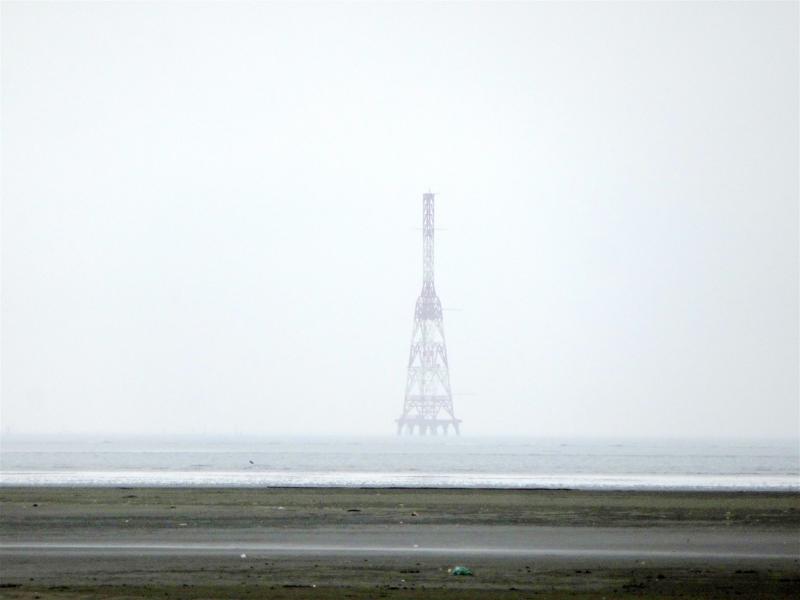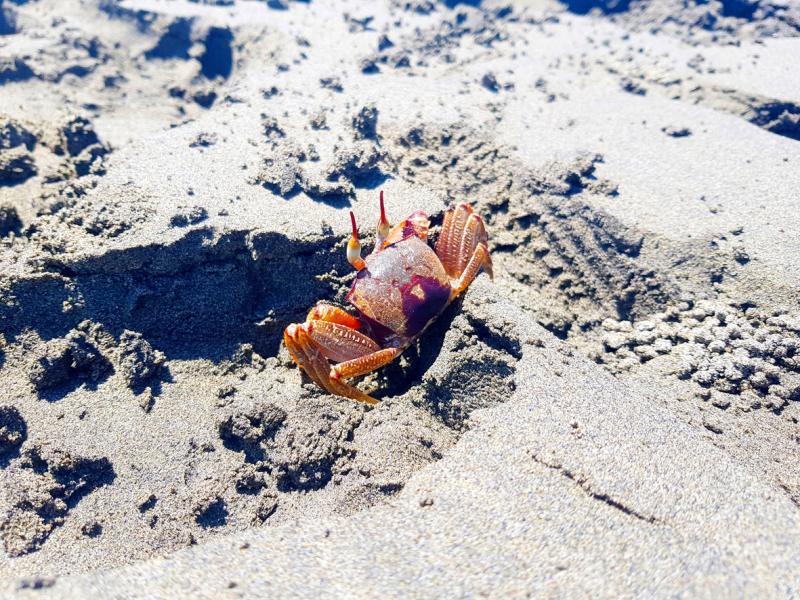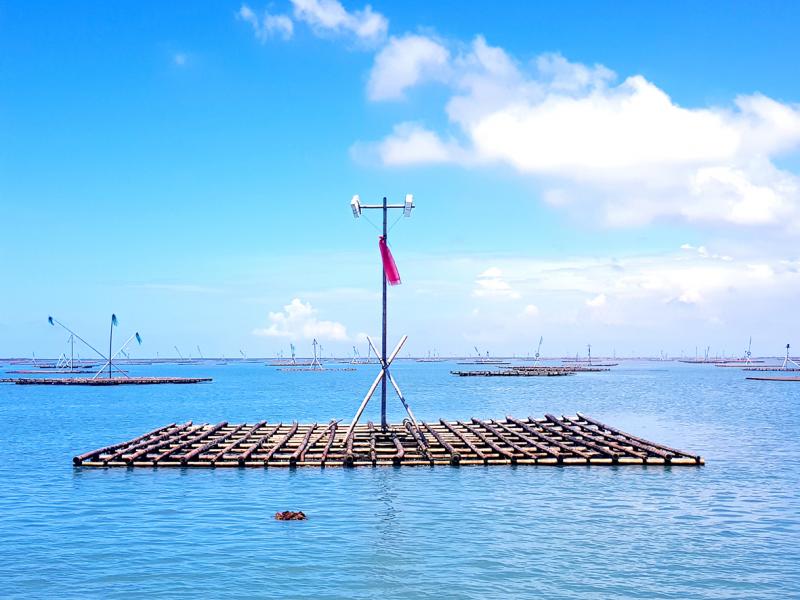Ten kilometers off the coast of Dongshih (東石) Fishing Harbor in Chiayi County, a long stretch of sand rises up from the seafloor, forming Waisanding Sandbar (外傘頂洲). This unassuming mass of sand is economically important for two reasons: Not only does it generate local tourism revenue from curious visitors, but it also offers protection to Dongshih’s offshore waters, Taiwan’s largest oyster-producing region.
OYSTER FARMS EVERYWHERE
Tourists who wish to visit Waisanding Sandbar may do so by boarding one of the tourist boats at Dongshih Fishing Harbor. Reservations are recommended as the boats often fill up with large local tour groups. The boat ride takes just under an hour, and at noon there is even a nice buffet seafood lunch included on board (with oysters, of course). The cost is NT$450 without lunch and NT$600 with lunch.

Photo: Tyler Cottenie
The ride out is usually quite calm. In fact, these flat-bottomed tourist boats have a very low profile and are clearly designed only to operate in the protected, shallow waters between Taiwan and the sandbar.
At the time of the Japanese takeover of Taiwan in 1895, Waisanding Sandbar was located off the coast of what is now southern Yunlin County. The sand that formed it was then being continually replenished by deposits from the Jhuoshuei River (濁水溪) system. At the time, the Beigang River (北港溪), which forms the border between today’s Yunlin and Chiayi counties, was a distributary of the mighty Jhuoshuei River. Large amounts of sand were being continuously delivered to the ocean adjacent to Waisanding Sandbar.
However, the Japanese built a dike in 1911 that severed the Beigang River’s connection to the Jhuoshuei River system. This greatly reduced the amount of sediment being carried downstream to the outlet at Beigang, setting in motion changes to Waisanding Sandbar that continue to this day. By the 1920s, Japanese maps show the sandbar had already drifted south by several kilometers. In the latter half of the 20th century, it began drifting toward the coast of Taiwan, and in recent years it has shrunk significantly. The sandbar now sits off the coast of Chiayi County, but due to historical tradition, still belongs to Yunlin County. A 2006 request by Chiayi to have jurisdiction over the sandbar handed over from Yunlin was denied.

Photo: Tyler Cottenie
On the way out to the sandbar, the boat navigates through oyster farming platforms, each adorned with a different colorful flag or other object to identify its owner. According to our guide, 70 percent of all oysters eaten in Taiwan come from the Dongshih area, and the boat ride out to Waisanding Sandbar gives one an appreciation for the massive scale of the oyster farming operations here. One can also understand why Chiayi County wants to have an active role in managing the protective sandbar.
The sandbar’s reduction in size has been compounded by the construction of check dams in nearby rivers, which have further reduced the amount of sediment reaching the ocean. It has been estimated that without intervention to replenish the sand or prevent further loss of sand, the sandbar may disappear altogether within the next eight years. However, officials this year have agreed on measures to protect the sandbar, including sandbagging, the construction of a groin and delivery of sediment from dredging operations in nearby harbors.
THE SANDBAR

Photo: Tyler Cottenie
Stepping off the boat onto the sandbar, it’s hard to imagine this place once had over 1,000 inhabitants. All one sees now is an enormous expanse of dark sand barely a meter above sea level, littered here and there with abandoned oyster farming equipment and random refuse from the ocean. Far to the east, taller buildings along the coast of Chiayi are visible. To the north, it’s sand as far as the eye can see. To the west, the rougher waters of the Taiwan Strait can be seen, as the sandbar is now less than 1km wide where the tourist boat beaches. Finally, to the south, there is a peculiar sight: a steel structure several stories high.
This structure is the Wengangdui Lighthouse (塭港堆燈塔). My original goal for the day was to walk over to it, time permitting. However, after only a few minutes of walking, it became apparent that there was no way I would reach it—unless I wanted to start swimming. The land around the lighthouse’s base has already been reclaimed by the ocean and the structure now sits about 1km off shore in the middle of the ocean.
This is not the first time the Wengangdui Lighthouse has been threatened by the shifting sands of this sandbar. First built in 1914, it collapsed after only six years. It was immediately rebuilt, but has suffered the same fate many times over since then. Altogether, it has been rebuilt seven times, more than any other Taiwanese lighthouse.

Photo: Tyler Cottenie
Most tourists spend their hour on the sandbar exploring the coastal marine life. Despite its desolate appearance, the sandbar is actually teeming with organisms that prefer the sheltered, shallow, sandy environment. At low tide, look closely and you may see a collection of tiny rubbery straws sticking out of the sand, made by resident tube worms. Keep your eyes peeled for the feisty orange horn-eyed ghost crab, or the smaller sand bubbler crabs, which leave the beach littered with tiny sand pellets. Finally, there are large hamaguri clams hiding in the sand. The tourist boats usually bring along rakes and shovels that tourists can borrow.
On a hot day, a cool dip in the ocean here might seem like a good idea. However, local attitudes toward water must be taken into account. When my travel partner attempted a quick swim, the backlash was swift and fierce. Tourists started gawking, the guide started running over and yelling at him and the captain of the boat even blasted the horn at him for the reckless behavior of swimming in calm ocean waters. Visitors to the sandbar might want to save themselves the trouble and just leave their swimsuits at home.
The ride back to Dongshih fishing harbor follows approximately the same route. With the main event over and nothing new to see, one might expect the mood to be rather subdued on the return trip. However, all tourist boats also come equipped with karaoke systems, making the return trip arguably the most lively part of the whole day. Our guide kicked things off with a solo piece before passing the microphone around for other passengers to join in. And join in they did. Later, there were even props and costumes. Blasting karaoke songs on a boat as we cruised by farmers tending to their oysters seemed like a fitting end to this excursion in rural Taiwan.

Photo: Tyler Cottenie
For more information, call: (09) 8901-1009 (Chinese).

June 9 to June 15 A photo of two men riding trendy high-wheel Penny-Farthing bicycles past a Qing Dynasty gate aptly captures the essence of Taipei in 1897 — a newly colonized city on the cusp of great change. The Japanese began making significant modifications to the cityscape in 1899, tearing down Qing-era structures, widening boulevards and installing Western-style infrastructure and buildings. The photographer, Minosuke Imamura, only spent a year in Taiwan as a cartographer for the governor-general’s office, but he left behind a treasure trove of 130 images showing life at the onset of Japanese rule, spanning July 1897 to

One of the most important gripes that Taiwanese have about the Democratic Progressive Party (DPP) is that it has failed to deliver concretely on higher wages, housing prices and other bread-and-butter issues. The parallel complaint is that the DPP cares only about glamor issues, such as removing markers of Chinese Nationalist Party (KMT) colonialism by renaming them, or what the KMT codes as “de-Sinification.” Once again, as a critical election looms, the DPP is presenting evidence for that charge. The KMT was quick to jump on the recent proposal of the Ministry of the Interior (MOI) to rename roads that symbolize

In an interview posted online by United Daily News (UDN) on May 26, current Chinese Nationalist Party (KMT) Chairman Eric Chu (朱立倫) was asked about Taichung Mayor Lu Shiow-yen (盧秀燕) replacing him as party chair. Though not yet officially running, by the customs of Taiwan politics, Lu has been signalling she is both running for party chair and to be the party’s 2028 presidential candidate. She told an international media outlet that she was considering a run. She also gave a speech in Keelung on national priorities and foreign affairs. For details, see the May 23 edition of this column,

On the evening of June 1, Control Yuan Secretary-General Lee Chun-yi (李俊俋) apologized and resigned in disgrace. His crime was instructing his driver to use a Control Yuan vehicle to transport his dog to a pet grooming salon. The Control Yuan is the government branch that investigates, audits and impeaches government officials for, among other things, misuse of government funds, so his misuse of a government vehicle was highly inappropriate. If this story were told to anyone living in the golden era of swaggering gangsters, flashy nouveau riche businessmen, and corrupt “black gold” politics of the 1980s and 1990s, they would have laughed.